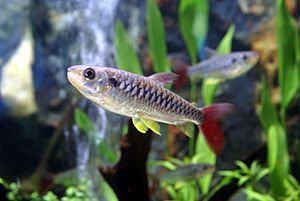Pinktail chalceus facts for kids
Quick facts for kids Pinktail chalceus |
|
|---|---|
 |
|
| Scientific classification | |
| Genus: |
Chalceus
|
| Species: |
macrolepidotus
|
The pinktail chalceus (Chalceus macrolepidotus) is a type of freshwater fish found in South America. It's also known as the pinktail characin. This fish belongs to the family Chalceidae and is one of five species in its group, called the Chalceus genus. It's also the main example, or "type species," for its genus.
Contents
About the Pinktail Chalceus
The pinktail chalceus is a small, light-colored fish. Its tail is usually a strong dark red or pink, much brighter than the rest of its body. This fish has large, easy-to-spot scales. It can grow to be about 24.5 centimeters (almost 10 inches) long, making it the biggest known fish in the Chalceus group. The smallest is a fish called Chalceus epakros.
Sometimes, people used to confuse Chalceus epakros with the pinktail chalceus or the yellowfin chalceus (Chalceus erythrurus). But you can tell the pinktail and C. epakros apart. The pinktail chalceus is a uniform silvery color. On the other hand, C. epakros has a line running down each side of its body, all the way to its tail base.
What Its Name Means
The common name "pinktail chalceus" comes from its tail fin. This fin is usually much brighter in color than the rest of the fish's body. The scientific name macrolepidotus means "large scale" in Latin. This name fits well because the fish does have big scales. These scales are a type called cycloid scales, which are smooth and round. When it was first described, it was called the "large-scaled chalceus."
The genus name Chalceus comes from the Greek word chalkos. This word means brass or copper. This name was given because the scales on the first fish studied looked coppery, and sometimes golden, when they were kept in alcohol.
Fish Family Tree
The pinktail chalceus was first described by a French scientist named Georges Cuvier in 1818. He placed it into a brand new group, or genus, called Chalceus. Because it was the only fish in this new group at the time, it became the type species for the genus. Over the years, more fish have been added to or removed from this group. After a new study of the genus in 2004, there are now five accepted species in total, including the pinktail chalceus.
The original scientific name Cuvier gave it is still its accepted name today. Some older names that were once used for this fish include Brycon macrolepidotus and Chalceus ararapeera. Interestingly, the name Chalceus erythrurus was once used for the pinktail chalceus, but it now belongs to a different species in the same group.
For a short time in 1941, a scientist named Shoji Nakashima even classified the yellowfin chalceus (C. erythrurus) as a subspecies of the pinktail chalceus, calling it Chalceus macrolepidotus iquitensis.
Where It Lives
The pinktail chalceus likes to live in waters in South America that have a lot of oxygen. This usually means fast-flowing rivers. You can find it in countries like French Guiana, Guyana, and Suriname. It lives in big rivers such as the Orinoco and Negro Rivers. The pinktail chalceus and C. epakros are the only two Chalceus species known to live in Guyana. This fish has also been found in Mexico, but it's not considered a harmful invasive species there.
What It Eats and How It Behaves
The pinktail chalceus is a very active fish that moves quickly. It usually stays close to the surface of the river. These fish often swim together in groups called schools. Their diet mainly consists of small invertebrates, which are tiny creatures without backbones, like insects. When looking for food, they might even jump out of the water to catch a bug flying above the surface!
These fish are known to be quite skittish, meaning they get easily scared. This is a trait they share with the yellowfin chalceus.
Pinktail Chalceus as Pets
The pinktail chalceus is somewhat popular in the aquarium hobby. However, it needs a larger fish tank than many people might have. It requires an aquarium of 55 gallons or more. These fish are known for jumping out of their tanks, just like they jump for food in the wild! Because of this, sellers often warn buyers about it. This is more likely to happen if the pinktail chalceus gets scared and doesn't have places to hide, like plants or pieces of driftwood.
If you have enough space to keep pinktails, it's best to have a group of more than 6 to 8 fish. If there are fewer, they might start fighting with each other. Since they are fast and active fish, their tank doesn't need a lot of extra decorations. But giving them places to hide can help them feel more relaxed.
Images for kids
See also
 In Spanish: Chalceus macrolepidotus para niños
In Spanish: Chalceus macrolepidotus para niños


